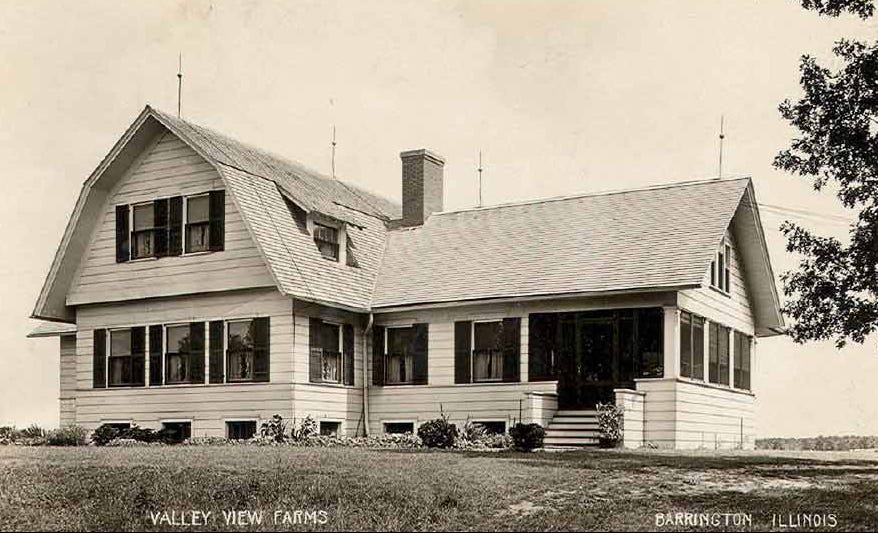
For the people who read this Substack, you might not know I’ve freelanced for Chicago magazine for the last year and a half writing up real estate blurbs. This past week while scrolling Zillow or whatever search engine for what seems like the millionth time, I came across a listing in Barrington Hills that I somehow missed, even though it’s been on and off the market for the last five years. Of course I fell down a rabbit hole as I tend to do just about every single time I research a building.
Originally built in 1910 by Chicagoan John V. Walker as a “gentleman’s farm” and weekend retreat, Valley View Farm in Barrington Hills currently sits on ten pastoral acres of mature trees and sweeping vistas. The original home has been updated beyond recognition into a sprawling Shingle-Style home of six bedrooms and eight bathrooms. But what I found intriguing was learning about the estate’s second owners, William D. and Frances T. Horne, who lived here starting in 1932 where they would raise four children. Due to poor eyesight, William “Bill” Horne (1892-1985) was rejected for military duty in World War I and instead became an ambulance driver, serving on the north front in Italy. This is how he first met famed writer Ernest Hemingway, who had been rejected by the U.S. Army for the same reason as Bill. “Ernie” and “Horney” became lifelong best friends.

Their friendship would last for decades beyond the war that first brought them together. In a 1970s interview Bill recalled their first meeting in New York City where “120 half-blind drivers” gathered for the ten-day crossing to France. He got to know the “handsome, 18-year-old giant named Ernest Hemingway” as they “sailed on the French Line ship Chicago.” As ambulance drivers based in the town of Schio they recovered wounded soldiers near the west end of the Italian-Austrian line. After the war Bill Horne found work in Chicago, selling axles for the Eaton Axel Company and Locomobile Automobile Company where he later served as advertising manager. He then became a partner in the advertising firm Fulton, Horne, Morrissey Co. In 1920 knowing Hemingway was heartbroken over American nurse Agnes von Kurowsky, the inspiration behind his novel A Farewell to Arms, Bill invited Ernie to live with him at a roominghouse in Chicago. “We rented a fourth-floor room in a house at 1230 N. State Street. It was the kind with a washstand in the corner and a bath down the hall. Meals weren’t included, so we usually ate at Kitso’s, a Greek restaurant on Division Street…I think Kitso’s was the scene of Ernie’s story, The Killers.” When Ernie married his first wife Hadley the next year, the couple moved around the block to a cramped, dark apartment at the top of a rundown building at 1239 N. Dearborn Parkway. They lived there for just three short months and soon escaped to Paris, but Ernie kept in touch with Bill, who visited Hemingway in Cuba in 1958, right before the revolution, as well as Montana and Key West. Ernie stayed with Bill and his wife “Bunny” in Barrington, enjoying the outdoor turquoise-colored pool they had added in the 1930s. The two men exchanged letters until Hemingway’s death in 1961. Bill served as an honorary pallbearer at the funeral. The letters the two men exchanged over the years is now part of Chicago’s Newberry Library.


But the story gets even more interesting when you find out Bill’s daughter, Luigi Louise, became an architect. A graduate of the School of Architecture at Cornell University, Luigi Horne Mumford went to work for Skidmore Owings Merrill (SOM) from 1959-1968, assisting Fazlur Kahn on the design for Chicago’s Chestnut-DeWitt Apartments, which was completed in 1966. It was the first building in the world to implement tubular construction. Back then it was extremely unusual for a woman to work in the field. German American architect Brigette Peterhans recalled in a 2007 interview that besides some “interior design girls” like Dolores Miller, there were only three women on the design floor of SOM in 1962: Luigi, Natalie de Blois, and herself. While both Brigette and Natalie later became partners at SOM, Luigi “didn’t really get very far” and was gone by the time Brigette returned to the firm in 1968. Luigi later worked as a technical specialist in the Department of Architecture at the Art Institute of Chicago. Born in January of 1931, two years after her parents’ marriage, Luigi was interviewed this past year by the Society of Architectural Historians. She recalled her “idyllic childhood” in Barrington and how her aunt, the only surviving sibling of Bill Horne, was married to Milwaukee architect Theodore L. Eschweiler (1895-1966). Eschweiler and Eschweiler was one of Milwaukee’s most prestigious architectural firms. Established in 1892, founder Alexander C. Eschweiler later entered into a partnership with his three sons Alexander, Jr., Theodore, and Carl in 1923. When she was 12-years-old, her uncle Theodore took Luigi to help “measure a building site,” which was the beginning of her journey in the world of architecture.




No. When Luigi (my mother) asked her in-laws if they were related my grandmother Mumford said "We always claim him, but her has never heard of us"
Shaw Mumford
Fascinating story. I wonder if Luigi is related (by marriage) to the famed architecture critic Lewis Mumford?